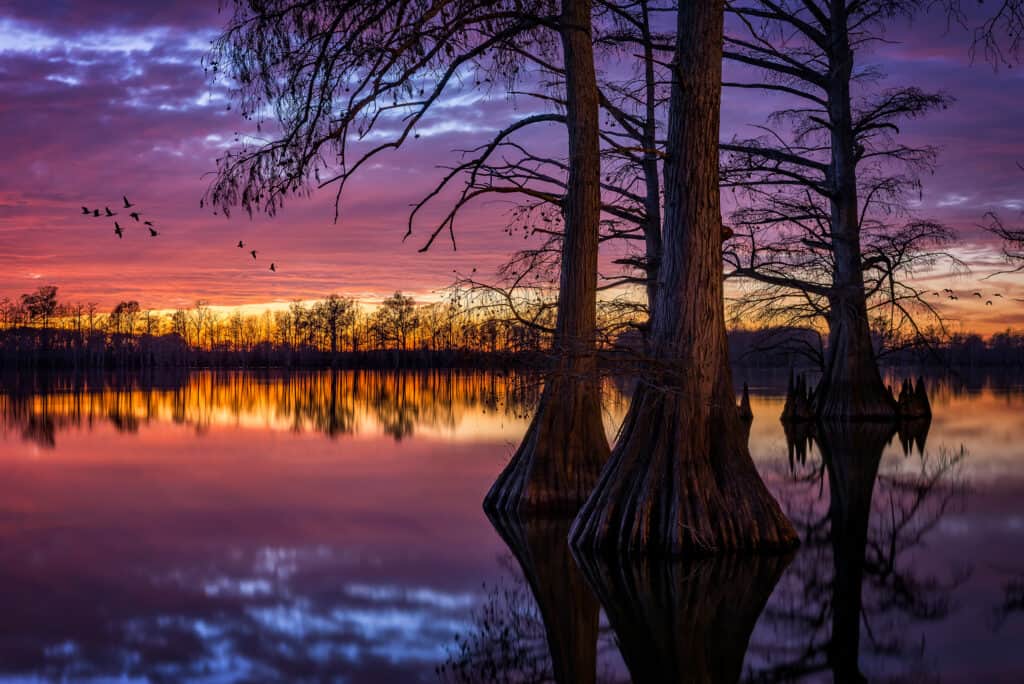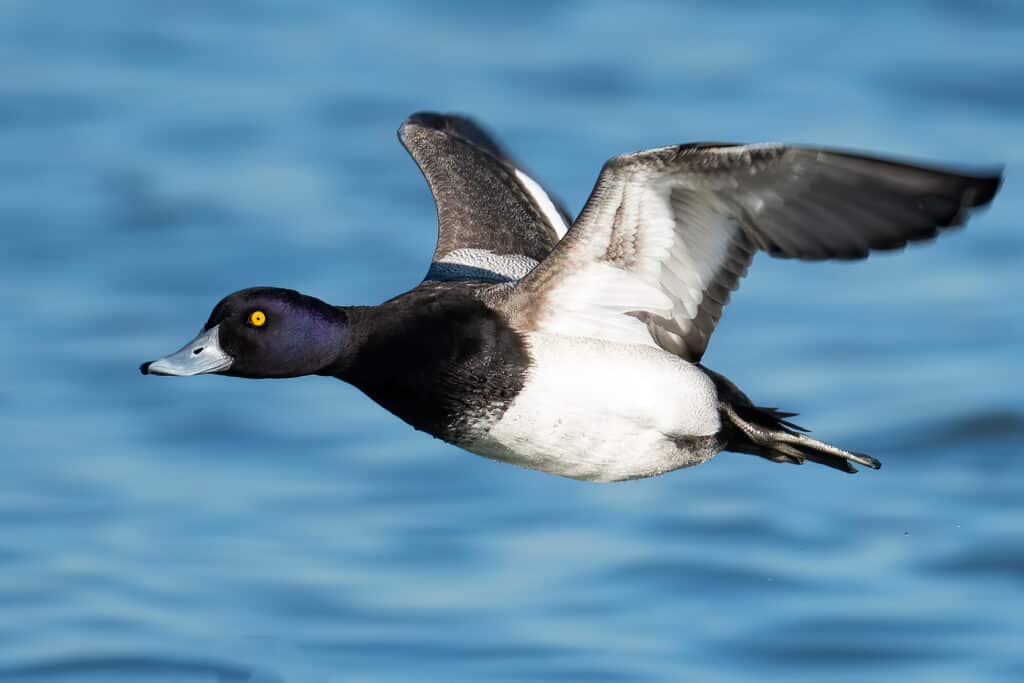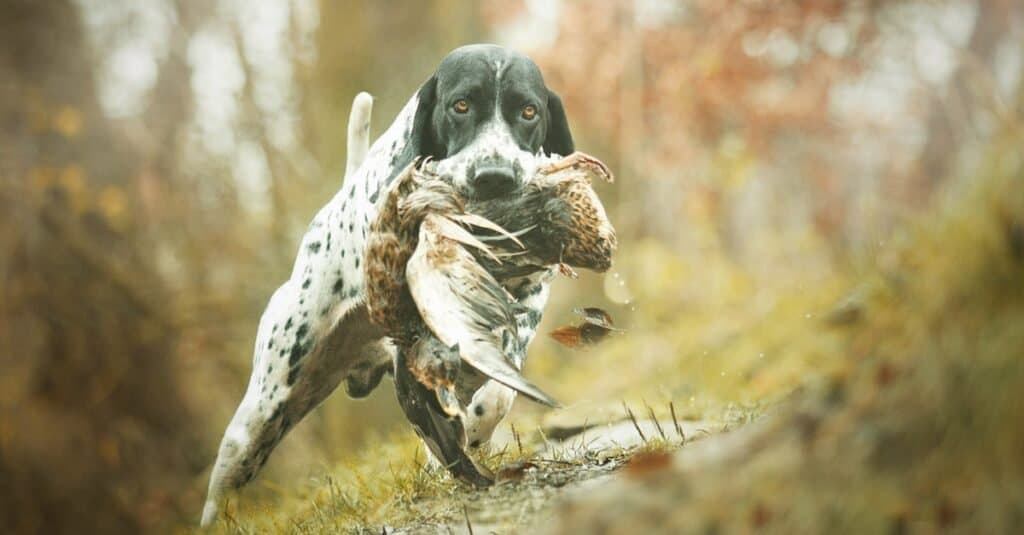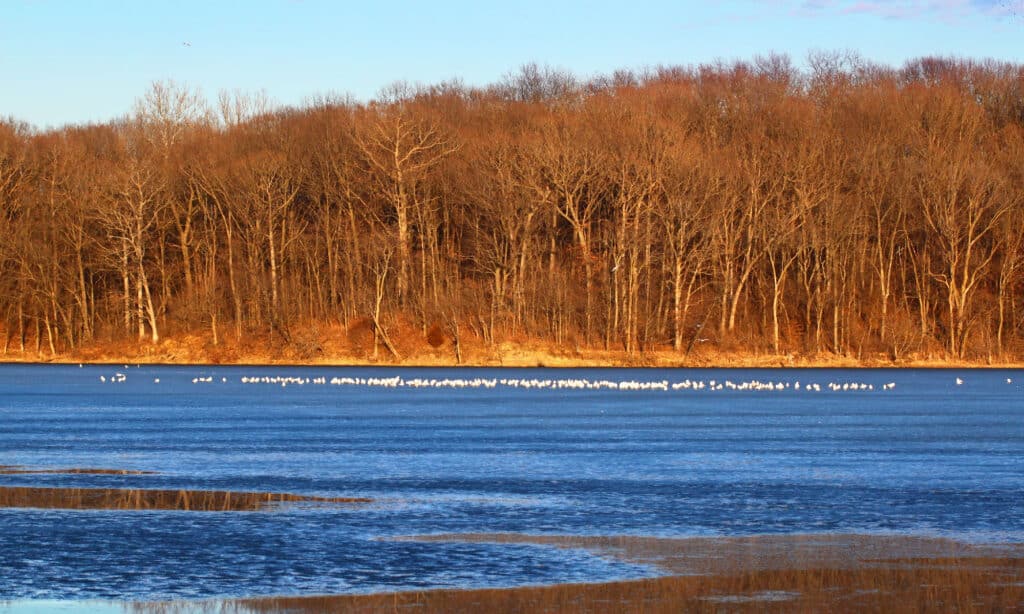You know that excited feeling you have before a hunt! You ask yourself if you have the best spread, did you forget to pack anything, will the ducks not disappoint? Duck hunting season is here and if you are hunting in Illinois there are plenty of excellent hunting to be had. Whether you’re one of the lucky hunters to win a draw this year or you plan to stake out your own blind along the Mississippi, here is everything you need to know about duck hunting season in Illinois including season dates, bag limits and more!
What Kinds of Ducks are in Illinois?

The Illinois bag limit for mergansers is 5.
©Brian E Kushner/Shutterstock.com
Illinois is right in the middle of the Mississippi Flyway with ducks migrating from the north taking layovers in the rivers, lakes and ponds in the state. Some of the most common duck species in Illinois include:
- Mallard
- Wood Duck
- Gadwall
- Teal
- Mergansers
- Coot
- Black Ducks
- Pintails
Where can you Duck Hunt in Illinois?

Places that have high duck harvest numbers include Horseshoe Lake, Meredosia Lake and along the Mississippi.
©Anthony heflin/Shutterstock.com
The best duck hunting in Illinois is along the Illinois River Valley. The Illinois River flows south west through central Illinois emptying into the Mississippi near Grafton, IL just north of St. Louis, MO. The Mississippi River also has amazing duck hunting from earl teal season to later mallards and gadwalls. The Illinois Department of Natural Resources State Fish and Wildlife Areas have designated areas for waterfowl hunting with some of the most popular being Woodford, Anderson, Rice and Sanganois. There are several National Wildlife Refuges that allow duck hunting as well including Meredosia, Emiquon, and Chautauqua NWR.
Many of the public hunting areas in Illinois require an application for a drawing with a chance to earn one of the hunting spots. The drawings are held at the end of July and the winners get access to the blind for one to three years.
What are the Hunting Zones in Illinois?
Illinois is divided into four zones; the North, Central, South Central and South Zone. A map with the boundary lines can be visited here on the Hunt Illinois website. The majority of the Illinois River is in the Central Zone which is one of the most hunted areas of Illinois.
Duck Hunting Season Dates in Illinois
| Species | North Zone | Central Zone | South Central Zone | South Zone |
| Teal | Sept. 10-25 Same Statewide | Same Statewide | Same Statewide | Same Statewide |
| Duck | Oct. 22-Dec. 20 | Oct. 29-Dec. 27 | Nov. 12-Jan. 10 | Dec. 3-Jan. 31 |
| Mergansers | Oct. 22-Dec. 20 | Oct. 29-Dec. 27 | Nov. 12-Jan. 10 | Dec. 3-Jan. 31 |
| Coot | Oct. 22-Dec. 20 | Oct. 29-Dec. 27 | Nov. 12-Jan. 10 | Dec. 3-Jan. 31 |
| Scaup | Oct. 22- Dec. 5 and Dec. 6-Dec. 20 | Oct. 29-Dec. 12 and Dec. 13- Dec. 27 | Nov. 12-Dec. 26 and Dec. 27-Jan. 10 | Dec. 3-Jan. 16 and Jan. 17-Jan. 31 |
Other Season Dates
| North Zone | Central Zone | South Central Zone | South Zone | |
| Youth Waterfowl Hunting Days | Oct. 15-16 | Oct. 22-23 | Nov. 5-6 | Nov. 26-27 |
Bag Limits and Possession Limits for Duck Hunting in Illinois

The bag limit for ducks in Illinois is 6 ducks of any species.
©Brian E. Kushner/Shutterstock.com
The bag limit for ducks in Illinois is 6 ducks of any species. Exceptions include the daily limit can consist of no more than the following: 4 mallards (of which no more than 2 can be hen mallards), 3 wood ducks, 2 Scaup for the first 45 days in each zone, 1 Scaup for the last 15 days in each zone, 2 redheads, 2 canvasback, 2 black ducks, 1 pintail and 1 mottled duck.
| Species | Bag Limits | Possession Limits |
| Ducks | 6 | 18 |
| Mergansers | 5 | 15 |
| Coots | 15 | 45 |
| Scaup (first 45 days/last 15 days) | 2/1 | 6/3 |
What are the Shooting Hours?

The best duck hunting in Illinois is along the Illinois River Valley.
©Charles Brutlag/Shutterstock.com
The shooting hours in Illinois are ½ hour before sunrise to sunset. When calculating the sunrise times, be sure to make note of daylight savings on Nov. 6, and the “fall back” timing. Plan to give yourself plenty of time to set up for your hunt so you are ready to shoot exactly a ½ hour before sunrise.
Gear up! What you Need for Duck Hunting

A beautiful Auvergne pointing dog hunting with a duck.
©Best dog photo/Shutterstock.com
In Illinois most of your duck hunting locations are only accessible by boat. There are a few shallow water sites but having (or renting) a duck boat, canoe or kayak will help you reach the prime locations. You can still keep it simple or go all out when it comes to duck hunting gear. Here is a starter list of gear you might need for duck hunting season in Illinois:
- Shotgun: a 12 gauge or 20 gauge (must not be larger than a 10 gauge)
- Gun case/bag/sleeve, waterproof is a must
- Shells: 3” shells are common, depends on the duck species you are targeting, shot must be nontoxic
- Duck blind or boat blind: There are a variety of blind set ups from A-frames to pits to layouts. Choosing the right blind depends a lot on your personal preference. It also depends if you are hunting on your own, with a group and are you bringing your dog. The most important thing is that your blind blends in. Make it as camouflaged as possible and remember the angle that the ducks will be coming in. Don’t forget headwear and face coverings.
- Life vest or PFD: If you will be hunting from a boat, kayak or canoe be sure to wear a life vest. Currents on the Illinois River and the Mississippi can get quite strong so having a properly fitting life vest is the safest route.
- Decoys: Choosing your decoy spread is half the fun of a successful hunt. The detail and craftsmanship in decoys today is remarkable with incredibly realistic looking and posed ducks of many species. You can even throw in some goose decoys to make it look more natural. Experienced duck hunters know there is a rhyme and reason to decoy placement and it is worth your time to do some research on decoy spreads.
- Camo: We are not talking about basic green and brown camo, but photo replicated camouflage that matches your specific habitat. The camo today is very detailed and can match a variety of settings like marshland, timbers and grain fields. You can even get camo for early season hunting with more green vegetation in it vs later season with brown/yellow/oranges to match the fall color changes. Your basic camo will work too, but with so many options out there you might want to try something different.
- Duck callers: You can start with a simple caller and then add more as you get more experienced. Practice makes perfect so listen to videos as well as ducks in the wild so you can learn their calls. Did you know they have duck calling contests around the world? The World Championship is held in Stuttgart Arkansas every year. Last years lucky winner was Haiden Richard. The next contest is coming up over Thanksgiving Weekend so you have a little time to practice.
- Waders and Boots: You have to have a comfortable, warm, waterproof pair of boots. It is a must. Waders are also great gear to have especially if you will be retrieving vs a dog. You can get one-piece waders/boot combo or separate.
- Dog (technically not “gear”, but enjoyable to have): Bringing your well trained dog along on a hunt is not necessary but it sure can be a great way to bond with your pup. Dogs bred for retrieving live for those weekends when they can get out and use their skills. Some of the most popular dogs for duck hunting are retrievers, pointers, and spaniels.
- First Aid Kit: It is always a good idea to bring a first aid kit along, just think of all the junk you’ve come across in the bottom of a lake or river. Be prepared for minor injuries.
Factors for Success

Clinton Lake is an excellent hunting, camping, and fishing getaway for Chicago locals and visitors to Illinois
©Jason Patrick Ross/Shutterstock.com
If you know you are hunting on Saturday at Sanganois you could roll into the parking lot a half-hour before sunrise but you wouldn’t be ready to go and could be missing out at the best early morning hunting. Planning is one of the key factors for success when it comes to duck hunting. You can read the weekly waterfowl reports, track the weather and scout the actual area you plan to hunt. If you won the draw and have the same blind all year you can still get to know the area as much as possible. Plan ahead, have the right gear, monitor the weather and you will be in for an exciting hunt.
Where are the Best Places to Duck Hunt in Illinois?
The Illinois River Valley has some of the best duck hunting especially in Sanganois State Fish and Wildlife Area. The conditions are just right for waterfowl of all kinds to stop during their migrations from the north. You will also find a fair number of geese in the Sanganois. Other places that have high harvest numbers include Horseshoe Lake, Meredosia Lake and along the Mississippi.
Meet the Species: 3 of the Most Common Ducks in Illinois

The gadwall is not a colorful duck and the females look much like the males.
©Kannan Sundaram/Shutterstock.com
- Mallard: When you hear the word “duck” the mallard is probably what you picture. They are the most common duck in the US. The male mallard has an emerald green head that shimmers a bit in the sun. In flight you can see the blue edged wings and the white underside with brown to gray backs.
- Wood Duck: Another beautifully colored bird is the wood duck. The males have an iridescent green head that changes color depending on the sun light. They have white and black markings on their heads with an orange mark behind their beak and red eyes. Their chests are rust colored, their backs silky black and their bellies are grey.
- Gadwall: The gadwall is not a colorful duck and the females look much like the males. Their coloration is mostly a speckled brown mix with an unremarkable head but black tail feathers and a white patch on their lower wings.
Up Next
The photo featured at the top of this post is © sallystap/Shutterstock.com
Sources
- Illinois Department of Natural Resources, Available here: https://huntillinois.org/waterfowl/
- Ducks Unlimited / Jay Anglin, Available here: https://www.ducks.org/hunting/waterfowl-hunting-destinations/five-2019-2020-public-waterfowling-hotspots-in-the-atlantic-flyway
- Brittanica, Available here: https://www.britannica.com/place/Illinois-River
- US Fish and Wildlife, Available here: https://www.fws.gov/media/migratory-bird-hunting-activity-and-harvest-during-2019-20-and-2020-21-hunting-seasons
- Wings Over the Prairie, Available here: https://www.stuttgartduckfest.com/duck-calling-championship
FAQs (Frequently Asked Questions)
Can you Duck hunt in Illinois?
Yes, you can duck hunt in Illinois. You need a hunting license, State Migratory Waterfowl Stamp, Federal Migratory Bird Stamp and a HIP Certification.
When does duck hunting season start in Illinois?
The duck hunting season begins on September 10 for early teal and Oct. 20 for ducks in the North Zone.
What are the most common ducks in Illinois?
The most common ducks harvested in Illinois are Mallard, Wood Duck and Gadwall.
What is the bag limit for Mallard ducks in Illinois?
Of the 6 duck limit 4 may be mallards with 2 of those being hens.
How does Illinois rank in the country for duck hunting harvest?
Illinois is ranked 11th in duck harvest (based on a 10-year average).
Thank you for reading! Have some feedback for us? Contact the AZ Animals editorial team.







